|
Snakes
|
Some
of the most common snakes in Ghana some of which are
poisonous but also very shy and keep away from humans as
much as possible are: Green Mamba, Black Mamba, Twig Snake,
African Python, Royal Python, Calabar Ground Python, Black
Cobra, Green Tree Viper, Gaboon Viper, Red Lined Snake,
Smyth's Water Snake, Puff Adder. |
|
poisonous snakes |
none poisonous snakes |
|
Gabon Viper,
Bitis gabonica |
African
rock python,
Python sebae |
|
Rhinoceros Viper,
Bitis nasicornis |
Royal
Python,
Python regius |
|
West African Gabon Viper, Bitis rhinoceros |
Saharan Sand Boa, Gongylophis muelleri |
|
Puff
Adder, Bitis arietans |
|
|
Green Mamba,
Dendroaspis viridis |
|
|
Black and White Cobra, Naja melanoleuca |
|
|
Twig
or Bird Snake, Thelotornis capensis |
|
|
Gabon Viper
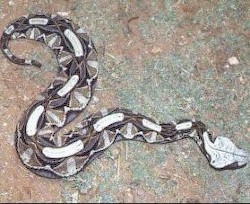 Bitis
gabonica is a venomous viper species found in the rainforests and savannas
of Sub-Saharan Africa. This is not only the largest member of the genus
Bitis, but also the world's heaviest viperid and it has the longest fangs
(up to 2 inches), and the highest venom yield of any venomous snake. Two
subspecies are currently recognized, including the nominate race described
here. Bitis
gabonica is a venomous viper species found in the rainforests and savannas
of Sub-Saharan Africa. This is not only the largest member of the genus
Bitis, but also the world's heaviest viperid and it has the longest fangs
(up to 2 inches), and the highest venom yield of any venomous snake. Two
subspecies are currently recognized, including the nominate race described
here.
Adults average
122–152 cm (4 to 5 feet) in length with a maximum of
205 cm (81 in) for a specimen collected in Sierra
Leone. The sexes may be distinguished by the length
of the tail in relation to the total length of the
body: approximately 12% for males and 6% for
females. Adults, especially females, are very heavy
and stout. One female had the following dimensions:
|
Total length |
174
cm (69 in) |
|
Head width |
12
cm (4.7 in) |
|
Girth |
37
cm (14.65 in) |
|
Weight (empty stomach) |
8.5
kg (19 lbs) |
In
their description of B. gabonica, Spawls et al.. (2004) give
an average length of 80–130 cm (32 to 51.5 in), with a
maximum size of 175 cm (69.3 in), saying the species may
possibly grow larger still. They acknowledge reports of
specimens over 6 feet (1.8 m), or even over 2 m (6.5 ft) in
length, but claim there is no evidence to support this.
The head is large and triangular, while the neck is greatly
narrowed: almost one-third the width of the head. A pair of
horns is present between the raised nostrils — tiny in B. g.
gabonica, but much larger in B. g. rhinoceros. The eyes are
large and moveable, set well forward, and surrounded by
15–21 circumorbital scales. There are 12–16 interocular
scales across the top of the head. 4–5 scale rows separate
the suboculars and the supralabials. There are 13–18
supralabials and 16–22 sublabials. The fangs may reach a
length of 55 millimetres (2.2 in) : the longest of any
venomous snake.
Midbody, there are 28–46 dorsal scale rows, all of which are
strongly keeled except for the outer rows on each side. The
lateral scales are slightly oblique. The ventral scales
number 124–140: rarely more than 132 in males, rarely less
than 132 in females. There are 17–33 paired subcaudal
scales: males have no fewer than 25, females no more than
23. The anal scale is single.
The color pattern consists of a series of pale,
sub-rectangular blotches running down the center of the
back, interspaced with dark, yellow-edged hourglass
markings. The flanks have a series of fawn of brown
rhomboidal shapes, with light vertical central bars. The
belly is pale with irregular brown or black blotches. The
head is white or cream with a fine, dark central line, black
spots on the rear corners, and a dark blue-black triangle
behind and below each eye. The iris color is cream,
yellow-white, orange or silvery
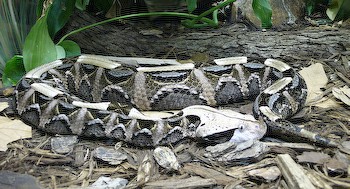 Gaboon viper, butterfly
adder, forest puff adder, swampjack, Gaboon adder, Gabon
viper. Originally a name given by the Portuguese, Gabon (Gabão)
refers to the estuary on which the town of Libreville was
built, in Gabon, and to a narrow strip of territory on
either bank of this arm of the sea. As of 1909, Gaboon
referred to the northern portion of French Congo, south of
the Equator and lying between the Atlantic Ocean and 12°
east longitude Gaboon viper, butterfly
adder, forest puff adder, swampjack, Gaboon adder, Gabon
viper. Originally a name given by the Portuguese, Gabon (Gabão)
refers to the estuary on which the town of Libreville was
built, in Gabon, and to a narrow strip of territory on
either bank of this arm of the sea. As of 1909, Gaboon
referred to the northern portion of French Congo, south of
the Equator and lying between the Atlantic Ocean and 12°
east longitude
This
species can be found in Guinea, Ghana, Togo, Nigeria,
Cameroon, DR Congo, Central African Republic, southern
Sudan, Uganda, Kenya, eastern Tanzania, Zambia, Malawi,
eastern Zimbabwe, Mozambique, northeast KwaZulu-Natal
Province in South Africa. Mallow et al. (2003) also list
Sierra Leone and Liberia in West Africa. The type locality
is given as "Gabon" (Africa).
 The
Gaboon viper is usually found in rainforests and nearby
woodlands, mainly at low altitudes, but sometimes as high as
1500 m. Spawls et al. (2004) mention a maximum altitude of
2100 m. According to Broadley and Cook (1975), it is
generally found in environments that are parallel to those
occupied by its close relative, B. arietans, which is
normally found in more open country. In Tanzania, this
species is found in secondary thickets, cashew plantations,
and in agricultural land under bushes and in thickets. In
Uganda, they are found in forests and nearby grasslands.
They also do well in reclaimed forest areas: cacao
plantations in West Africa and coffee plantations in East
Africa. They have been found in evergreen forests in Zambia.
In Zimbabwe, they only occur in areas of high rainfall along
the forested escarpment in the east of the country. In
general they may also be found in swamps, as well as in
still and moving waters. They are commonly found in
agricultural areas near forests and on roads at night. The
Gaboon viper is usually found in rainforests and nearby
woodlands, mainly at low altitudes, but sometimes as high as
1500 m. Spawls et al. (2004) mention a maximum altitude of
2100 m. According to Broadley and Cook (1975), it is
generally found in environments that are parallel to those
occupied by its close relative, B. arietans, which is
normally found in more open country. In Tanzania, this
species is found in secondary thickets, cashew plantations,
and in agricultural land under bushes and in thickets. In
Uganda, they are found in forests and nearby grasslands.
They also do well in reclaimed forest areas: cacao
plantations in West Africa and coffee plantations in East
Africa. They have been found in evergreen forests in Zambia.
In Zimbabwe, they only occur in areas of high rainfall along
the forested escarpment in the east of the country. In
general they may also be found in swamps, as well as in
still and moving waters. They are commonly found in
agricultural areas near forests and on roads at night.
Primarily nocturnal, Gaboon vipers have a reputation for
being slow-moving and placid. They usually hunt by ambush,
often spending long periods motionless, waiting for suitable
prey to happen by. On the other hand, they have been known
to hunt actively, mostly during the first six hours of the
night. In Kumasi, Ghana, they were regularly killed around
some stables in an open area with the forest some 500 meters
away — a sign that they were hunting rats in the grassland.
They are usually very tolerant snakes, even when handled,
and rarely bite or hiss, unlike most vipers. However, bites
by bad-tempered individuals do occur. An ambush predator,
its color pattern gives it excellent camouflage. This is B.
g. rhinoceros.Locomotion is mostly rectilinear, in a
sluggish "walking" motion of the ventral scales. They may
writhe from side to side when alarmed, but only for short
distances. Ditmars (1933) even described them as being
capable of sidewinding. If threatened, they may hiss loudly
as a warning, doing so in a deep and steady rhythm, slightly
flattening the head at the expiration of each breath.
Despite this, they are unlikely to strike unless severely
provoked.
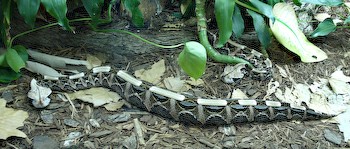 There have been
numerous descriptions of their generally unaggressive
nature. Sweeney (1961) wrote that they are so docile that
they "can be handled as freely as any non-venomous species",
although this is absolutely not recommended. In Lane (1963),
Ionides explains that he would capture specimens by first
touching them lightly on the top of the head with a pair of
tongs to test its reaction. Anger was rarely displayed, so
the tongs were usually set aside and the snake firmly
grasped by the neck with one hand and the body supported
with the other as he picked it up and carried it to a box
for containment. He said the snakes hardly ever struggled. There have been
numerous descriptions of their generally unaggressive
nature. Sweeney (1961) wrote that they are so docile that
they "can be handled as freely as any non-venomous species",
although this is absolutely not recommended. In Lane (1963),
Ionides explains that he would capture specimens by first
touching them lightly on the top of the head with a pair of
tongs to test its reaction. Anger was rarely displayed, so
the tongs were usually set aside and the snake firmly
grasped by the neck with one hand and the body supported
with the other as he picked it up and carried it to a box
for containment. He said the snakes hardly ever struggled.
Parry (1975) describes how this species has a wider range of
eye movement than other snakes. Along a horizontal plane,
eye movement can be maintained even if the head is rotated
up or down to an angle of up to 45°. If the head is rotated
360°, one eye will tilt up and the other down, depending on
the direction of rotation. Also, if one eye looks forwards
the other looks back, as if both are connected to a fixed
position on an axis between them. In general, the eyes often
flick back and forth in a rapid and jerky manner. When
asleep, there is no eye movement and the pupils are strongly
contracted. The pupils dilate suddenly and eye movement
resumes when the animal wakes up.
Bites
are relatively rare, due to their docile nature and the fact
that their range is mainly limited to rainforest areas. Due
to their sluggishness and unwillingness to move even when
approached, people are often bitten after they accidentally
step on them, but even then in some cases they may not bite.
However, when a bite does occur it should always be
considered a serious medical emergency. Even an average bite
from an average sized specimen is potentially fatal.
Antivenom should be administered as soon as possible to save
the victim's life if not the affected limb
In humans, a bite causes rapid and conspicuous swelling,
intense pain, severe shock and local blistering. Other
symptoms may include uncoordinated movements, defecation,
urination, swelling of the tongue and eyelids, convulsions
and unconsciousness. Blistering, bruising and necrosis may
be extensive. There may be sudden hypotension, heart damage
and dyspnoea. The blood may become incoagulable with
internal bleeding that may lead to haematuria and
haematemesis.Local tissue damage may require surgical
excision and possibly amputation. Healing may be slow and
fatalities are not uncommon. |
Top of Page
|
Rhinoceros Viper
Bitis
nasicornis is a venomous viper species found in the forests
of West and Central Africa. A big viper known for its
striking color pattern and prominent horns on its nose. No
subspecies are recognized.
Large
and stout,ranging in length from 72 cm to 107 cm. Spawls et
al. (2004) mention a maximum length of 120 cm, but admit
that this is exceptional, quoting an average length of 60–90
cm. Females become larger than males.
The head is narrow, flat, triangular and relatively small
compared to the rest of the body. The neck is thin. They
have a distinctive set of 2-3 horn-like scales on the end of
their nose, the front pair of which may be quite long. The
eyes are small and set well forward. The fangs are not
large: rarely more than 1.5 cm in length.
Midbody there are 31-43 dorsal scale rows. These are so
rough and heavily keeled that they sometimes inflict cuts on
handlers when the snake struggles. There are 117-140 ventral
scales and the anal scale is single. Mallow et al. (2003)
say that the subcaudals number 16-32 with males having a
higher count (25-30) than females (16-19). Spawls et al.
(2004) state that there are 12-32 subcaudals, that they are
paired, and that males having higher numbers of them.
The color pattern consists of a series of 15-18 blue or
blue-green oblong markings, each with a lemon-yellow line
down the center. These are enclosed within irregular black
rhombic blotches. A series of dark crimson triangles run
down the flanks, narrowly bordered with green or blue. Many
of the lateral scales have white tips, giving the snake a
velvety appearance. The top of the head is blue or green,
overlaid with a distinct black arrow mark. The belly is dull
green to dirty white, strongly marbled and blotched in black
and gray. Western specimens are more blue, while those from
the east are more green. After they shed their skin, the
bright colors fade quickly as silt from their generally
moist habitat accumulates on the rough scales.
From
Guinea to Ghana in West Africa, and in Central Africa in the
Central African Republic, southern Sudan, Cameroon, Gabon,
Congo, DR Congo, Angola, Rwanda, Uganda and western Kenya.
The type locality is listed only as "interior parts of
Africa."
Primarily nocturnal, they hide during the day in leaf
litter, in holes, around fallen trees or tangled roots of
forest trees. Their vivid coloration actually gives them
excellent camouflage in the dappled light conditions of the
forest floor, making them almost invisible. Although mainly
terrestrial, they are also known to climb into trees and
thickets where they have been found up to 3 m above the
ground. This climbing behavior is aided by a tail that is
prehensile to a certain extent. They are sometimes found in
shallow pools and have been described as powerful swimmers.
They are slow moving, but capable of striking quickly,
forwards or sideways, without coiling first or giving a
warning. Holding them by the tail is not safe; as it is
somewhat prehensile, they can use it to fling themselves
upwards and strike. They have been described as generally
placid creatures; less so than B. gabonica, but not as
bad-tempered as B. arietans. When approached, they often
reveal their presence by hissing. Said to produce the
loudest hiss of any African snake—almost a shriek
Because of its restricted range, few bites have been
reported. No statistics are available. There are only a few
detailed reports of human envenomation. Massive swelling,
which may lead to necrosis, had been described. In 2003 a
man in Dayton, Ohio, who was keeping a specimen as a pet,
was bitten and subsequently died. There is at least one
antivenin that protects specifically against bites from this
species: India Antiserum Africa Polyvalent. |
Top of Page
|
West African Gabon Viper
Bitis
gabonica rhinoceros is a venomous viper subspecies found in
West Africa. It is distinguished from the nominate
subspecies primarily by the presence of a set of large nasal
horns.
Bitis
gabonica rhinoceros has a distinctive set of enlarged nasal
scales that look like a pair of horns on its nose. This is a
characteristic that it shares with a close relative, B.
nascornis. However, B. nasicornis has a brighter color
pattern and a narrower head. Bitis gabonica gabonica has no
such enlarged nasal horns, and is overall somewhat smaller
than Bitis gabonica. rhinoceros. Also, with Bitis gabonica
gabonica, the dark triangular marking leading back from the
eye towards the angle of the mouth is divided. With Bitis
gabonica rhinoceros it is not.
The
Geographic range is West Africa from Ghana west to Guinea,
including Sierra Leone, Liberia and Ivory Coast. Togo is
also mentioned.
According to Spawls & Branch (1995), Ghana and Togo are at
the eastern limit of the range of this subspecies, and they
begin to intergrade here with B. g. gabonica. The
distribution map they provide indicates that the general
range for B. g. rhinoceros does not include Togo, but that
there has been at least one report of a specimen found
there. Togo, together with Benin and at least eastern Ghana,
are part of a larger region known as the Dahomey Gap; a
relatively dry region that separates the rainforests of West
Africa from those of Central Africa. |
Top of Page
|
Puff
Adder
 Bitis
arietans is a venomous viper species found in savannah and
grasslands from Morocco and western Arabia throughout Africa
except for the Sahara and rain forest regions. Its wide
distribution, common occurrence, large size. Two subspecies
are currently recognized, including the nominate subspecies
described here. Bitis
arietans is a venomous viper species found in savannah and
grasslands from Morocco and western Arabia throughout Africa
except for the Sahara and rain forest regions. Its wide
distribution, common occurrence, large size. Two subspecies
are currently recognized, including the nominate subspecies
described here.
The average size is
about 1 m in length and very stout. Large specimens of 190
cm (75 in), weighing over 6.0 kg (13.2 lbs) and with a girth
of 40 cm (16 in) have been reported. Specimens from Saudi
Arabia are not as large, usually no more than 80 cm in
length. Males are usually larger than females and have
relatively longer tails.
The head has a less than triangular shape with a blunt and
rounded snout. Still, it is much wider than the neck. The
rostral scale is small. The circumorbital ring consists of
10–16 scales. Across the top of the head, there are 7–11
interocular scales. 3–4 scales separate the suboculars and
the supralabials. There are 12–17 supralabials and 13–17
sublabials. The first 3–4 sublabials contact the chin
shields. Often, there are two fangs on each maxilla and both
can be functional.
Midbody there are 29–41 rows of dorsal scales. These are
strongly keeled except for the outermost rows. The ventral
scale count is 123–147, the subcaudals 14–38. Females have
no more than 24 subcaudals. The anal scale is single.
The color pattern varies geographically. The head has two
well-marked dark bands: one on the crown and the other
between the eyes. On the sides of the head, there are two
oblique dark bands or bars that run from the eye to the
supralabials. Below, the head is yellowish white with
scattered dark blotches. Iris color ranges from gold to
silver-gray. Dorsally, the ground-color varies from straw
yellow, to light brown, to orange or reddish brown. This is
overlaid with a pattern of 18–22 backwardly-directed, dark
brown to black bands that extend down the back and tail.
Usually these bands are roughly chevron-shaped, but may be
more U-shaped in some areas. They also form 2–6 light and
dark cross-bands on the tail. Some populations are heavily
flecked with brown and black, often obscuring other
coloration, giving the animal a dusty-brown or blackish
appearance. The belly is yellow or white, with a few
scattered dark spots. Newborn young have golden head
markings with pinkish to reddish ventral plates toward the
lateral edges.
One unusual specimen, described by Branch and Farrell
(1988), from Summer Pride, East London in South Africa, was
striped. The pattern consisted of a narrow (1 scale wide)
pale yellow stripe that ran from the crown of the head to
the tip of the tail. Generally, though, these are relatively
dull-looking snakes, except for male specimens from highland
east Africa and Cape Province, South Africa, that usually
have a striking yellow and black color pattern.
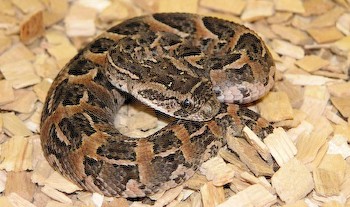 This species is probably
the most common and widespread snake in Africa. It is found
in most of sub-Saharan Africa south to the Cape of Good
Hope, including southern Morocco, Mauritania, Senegal, Mali,
southern Algeria, Guinea, Sierra Leone, Ivory Coast, Ghana,
Togo, Benin, Niger, Nigeria, Chad, Sudan, Cameroon, Central
African Republic, northern, eastern and southern Democratic
Republic of the Congo, Uganda, Kenya, Somalia, Rwanda,
Burundi, Tanzania, Angola, Zambia, Malawi, Mozambique,
Zimbabwe, Botswana, Namibia and South Africa. It also occurs
on the Arabian peninsula, where it is found in southwestern
Saudi Arabia and Yemen. The type locality given is "Promontorio
bonae spei" (Cape of Good Hope, South Africa). This species is probably
the most common and widespread snake in Africa. It is found
in most of sub-Saharan Africa south to the Cape of Good
Hope, including southern Morocco, Mauritania, Senegal, Mali,
southern Algeria, Guinea, Sierra Leone, Ivory Coast, Ghana,
Togo, Benin, Niger, Nigeria, Chad, Sudan, Cameroon, Central
African Republic, northern, eastern and southern Democratic
Republic of the Congo, Uganda, Kenya, Somalia, Rwanda,
Burundi, Tanzania, Angola, Zambia, Malawi, Mozambique,
Zimbabwe, Botswana, Namibia and South Africa. It also occurs
on the Arabian peninsula, where it is found in southwestern
Saudi Arabia and Yemen. The type locality given is "Promontorio
bonae spei" (Cape of Good Hope, South Africa).
Not found in rainforest areas, such as along the coast of
West Africa and in Central Africa (i.e., central DR Congo).
It is also absent from the Mediterranean coastal region of
North Africa. On the Arabian peninsula, it is found as far
north as Ta'if. There are also reports that it has been
found in the Dhofar region of southern Oman.
Normally a sluggish
species that relies on camouflage for protection. Locomotion
is primarily rectilinear, using their broad ventral scales
in a caterpillar fashion and aided by their own weight for
traction. When agitated, they can resort to a typical
serpentine movement and move with surprising speed.
Although mainly terrestrial, these snakes are good swimmers
and can also climb with ease; often they are found basking
in low bushes. One specimen was found 4.6 m above the ground
in a densely branched tree.
If disturbed, they will hiss loudly and continuously,
adopting a tightly coiled defensive posture with the fore
part of their body held in a taut "S" shape. At the same
time, they may attempt to back away from the threat towards
cover. They may strike suddenly and at a high speed, to the
side as easily as forwards, before returning quickly to the
defensive position, ready to strike again. During a strike,
the force of the impact is so strong, and the long fangs
penetrate so deeply, that prey items are often killed by the
physical trauma alone. The fangs are apparently able to
penetrate soft leather. They can strike to a distance of
about one third of their body length, but juveniles will
launch their entire bodies forwards in the process. These
snakes rarely grip their victims, instead releasing quickly
to return to the striking position.
This species is
responsible for more fatalities than any other African
snake. This is due to a combination of factors, including
its wide distribution, common occurrence, large size, potent
venom that is produced in large amounts, long fangs, their
habit of basking by footpaths and sitting quietly when
approached.
In humans, bites from this species can produce severe local
and systemic symptoms. Based on the degree and type of local
effect, bites can be divided into two symptomatic
categories: those with little or no surface extravasation,
and those with hemorrhages evident as ecchymosis, bleeding
and swelling. In both cases there is severe pain and
tenderness, but in the latter there is widespread
superficial or deep necrosis. Serious bites cause limbs to
become immovably flexed as a result of significant
hemorrhage or coagulation in the affected muscles. Residual
induration, however, is rare and usually these areas
completely resolve.
Other bite symptoms that may occur in humans include edema,
which may become extensive, shock, watery blood oozing from
the puncture wounds, nausea and vomiting, subcutaneous
bruising, blood blisters that may form rapidly, and a
painful swelling of the regional lymph nodes. Swelling
usually decreases after a few days, except for the area
immediately around the bite site. Hypotension, together with
weakness, dizziness and periods of semi- or unconsciousness
is also reported.
If not treated carefully, necrosis will spread, causing
skin, subcutaneous tissue and muscle to separate from
healthy tissue and eventually slough with serous exudate.
The slough may be superficial or deep, sometimes down to the
bone. Gangrene and secondary infections commonly occurs and
can result in loss of digits and limbs.
Despite all of this, deaths are exceptional and probably
occur in less than 10% of all untreated cases, usually in
2–4 days from complications following blood volume deficit
and a disseminated intravascular coagulopathy. Most
fatalities are associated with bad clinical management and
neglect. |
Top of Page
|
Green Mamba
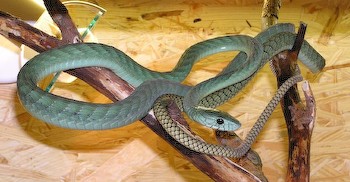 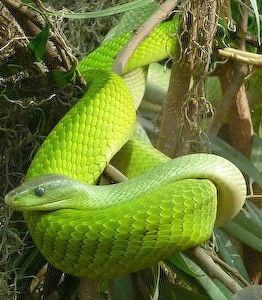 The
western green mamba or West African green mamba (Dendroaspis
viridis) is a long, thin venomous arboreal snake native to
West Africa, including Liberia and Côte d’Ivoire. It has
large green scales outlined in black, and grows up to two
meters in length. The scales on its long tail are yellow and
edged in black. It is mostly diurnal, but may be active at
night as well. Its habitat is the rainforest. Its natural
prey includes birds, lizards, and mammals. Two very close
relatives of the Western green mamba are the Eastern green
mamba, and the Black mamba. The
western green mamba or West African green mamba (Dendroaspis
viridis) is a long, thin venomous arboreal snake native to
West Africa, including Liberia and Côte d’Ivoire. It has
large green scales outlined in black, and grows up to two
meters in length. The scales on its long tail are yellow and
edged in black. It is mostly diurnal, but may be active at
night as well. Its habitat is the rainforest. Its natural
prey includes birds, lizards, and mammals. Two very close
relatives of the Western green mamba are the Eastern green
mamba, and the Black mamba. |
Top of Page
|
Black and
White Cobra
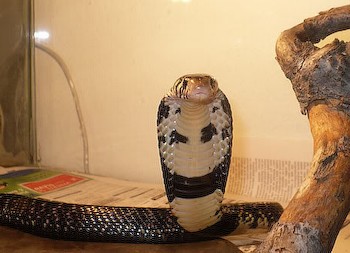 Length,
59-79 in. (150-200 cm). Occasionally they can reach lengths
of up to 300 cm. The highly glossy dorsal area can vary from
brown, brownish grey to black. While most individuals are
uniformly black or brown some specimens may have a vague
pattern of lighter scales and lines across the back which
give the appearance of narrow cross-bands. The ventral area
is yellowish or white with several wide dark bands. The head
is black or yellowish brown with distinct light cream labial
scales with dark edges. Length,
59-79 in. (150-200 cm). Occasionally they can reach lengths
of up to 300 cm. The highly glossy dorsal area can vary from
brown, brownish grey to black. While most individuals are
uniformly black or brown some specimens may have a vague
pattern of lighter scales and lines across the back which
give the appearance of narrow cross-bands. The ventral area
is yellowish or white with several wide dark bands. The head
is black or yellowish brown with distinct light cream labial
scales with dark edges.
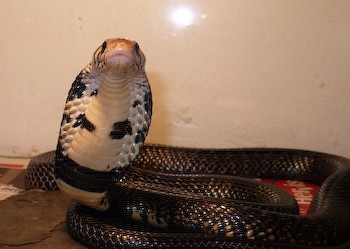 The geographic Range is
(Africa) Angola, Benin, Burkina Faso, Cameroon, Central
African Republic, Chad, Democratic Republic of the Congo
(Zaire), Congo, Ethiopia, Gabon, Ghana, Guinea Bissau,
Gambia, Guinea, Ivory Coast, Kenya, Liberia, Malawi, Mali,
Mozambique, Niger, Nigeria, Republic of South Africa,
Senegal, Sierra Leone, São Tomé, Somalia, Sudan, Tanzania,
Togo, Uganda, Zambia, Zimbabwe The geographic Range is
(Africa) Angola, Benin, Burkina Faso, Cameroon, Central
African Republic, Chad, Democratic Republic of the Congo
(Zaire), Congo, Ethiopia, Gabon, Ghana, Guinea Bissau,
Gambia, Guinea, Ivory Coast, Kenya, Liberia, Malawi, Mali,
Mozambique, Niger, Nigeria, Republic of South Africa,
Senegal, Sierra Leone, São Tomé, Somalia, Sudan, Tanzania,
Togo, Uganda, Zambia, Zimbabwe
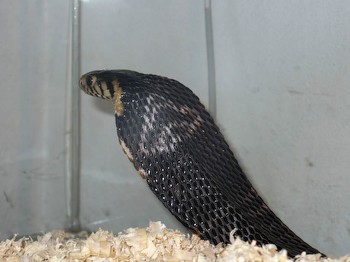 Habitat:
Savannah, grasslands, costal areas, and forest habitats from
sea level to 2500 meters. Habitat:
Savannah, grasslands, costal areas, and forest habitats from
sea level to 2500 meters.
Forestcobras are big and
extremely fast snakes that can move quick on land in the
water and in the trees. They are able to rise up almost
two-thirds of their body length and will stand their ground
and attack when cornered. Due to its neurotoxic venom, size
and disposition, this snake it is considered extremely
dangerous. |
Top of Page
|
Twig or Bird
Snake
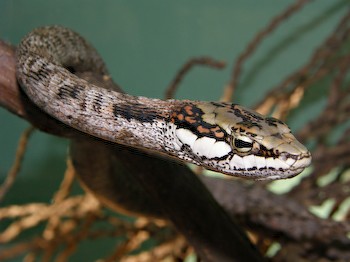 The
twig or bird snakes of the genus Thelotornis are a group of
back-fanged, colubrid snakes in the family Colubridae. All
species have a slender and elongated profile, a long tail,
narrow head and pointed snout. The eyes of each species have
horizontal pupils, shaped like keyholes, which gives twig
snakes binocular vision. Twig snakes are greyish-brown with
faint light and dark markings. When threatened, they inflate
their throat to display bold black markings between the
scales. The
twig or bird snakes of the genus Thelotornis are a group of
back-fanged, colubrid snakes in the family Colubridae. All
species have a slender and elongated profile, a long tail,
narrow head and pointed snout. The eyes of each species have
horizontal pupils, shaped like keyholes, which gives twig
snakes binocular vision. Twig snakes are greyish-brown with
faint light and dark markings. When threatened, they inflate
their throat to display bold black markings between the
scales.
The twig snake is one of
the several back-fanged colubrids whose bite is highly
venomous and potentially fatal. The venom is hemotoxic, and
although its effects are very slow, and bites are rare, no
antivenom has been developed and several fatalities (such as
Robert Mertens) have occurred.
The African twig snakes
are distinctive in appearance and unlikely on that continent
to be mistaken for any other snake, if indeed the observer
notices them. Preying on lizards, frogs and sometimes birds,
they conceal themselves in trees, but often at a low enough
level to be able to also strike at terrestrial prey, which
they may swallow upwards after killing. Their cryptic
coloration and apparent ability to freeze or sway gently, as
chameleons do, like a twig on a tree (hence the name) makes
them hard to spot. Indeed, they may be more abundant in
areas than is immediately obvious.
Thelotornis is
characterised by a depressed and flat head, keyhole-shaped
pupils, and in T. kirtlandii, a projecting canthus rostralis
which forms a shallow loreal groove on each side of the
head. This allows a certain amount of binocular vision to
the snake. In appearance, the head at least is unlikely to
be mistaken for any other African snake. Other
characteristics include a very long tail and large back
fangs. |
Top of Page
|
African Rock
Python
Python sebae is a no venomous python species found in
sub-Saharan Africa. This is one of the world's largest
species of snakes. Two subspecies are currently recognized,
including the nominate subspecies described here.
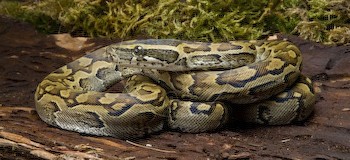 Python sebae was first
described by Johann Friedrich Gmelin in 1788. Its generic
name Python is a Greek word Πύθων referring to the enormous
serpent at Delphi slain by Apollo in Greek Mythology. Its
specific name sebae is a Latinized genitive form of Dutch
zoologist, Albertus Seba's last name. Python sebae was first
described by Johann Friedrich Gmelin in 1788. Its generic
name Python is a Greek word Πύθων referring to the enormous
serpent at Delphi slain by Apollo in Greek Mythology. Its
specific name sebae is a Latinized genitive form of Dutch
zoologist, Albertus Seba's last name.
This
is one of the world's largest species of snakes, with adults
reaching lengths of over 6 m (20 ft). The typical adult
length is 4.8 m (16 ft) and rumors of specimens over 6 m (20
ft) are generally considered reliable, but larger specimens
have never been confirmed.
The
color pattern is typically brown, with olive and tan
irregular blotching, fading to white on the underside. At a
glance, they can be easily mistaken for the Burmese python,
P. m. bivittatus, but the two species are not closely
related.
Found
in Africa south of the Sahara from Senegal east to Ethiopia
and Somalia, including Guinea-Bissau, Mali, Guinea, Sierra
Leone, Liberia, Ivory Coast, Upper Volta, Ghana, Togo,
Niger, Nigeria, Cameroon, Equatorial Guinea, Chad, Central
African Republic, Democratic Republic of the Congo, Angola,
Rwanda, Burundi, Sudan, Uganda, Kenya, Tanzania, Zambia,
Malawi, Mozambique, Zimbabwe south to northern Namibia,
Botswana and north-eastern South Africa (to Natal).
Extirpated from eastern Cape Province in 1927. The type
locality given is "America" -- an obvious mistake. According
to Loveridge (1936), no type locality was given. According
to Stimson (1969) it was "Guiara, Brazil."
 In
2009, the African rock python was found in the Florida
Everglades, and is feared to be establishing itself as an
invasive species alongside the already-established Burmese
Python. In
2009, the African rock python was found in the Florida
Everglades, and is feared to be establishing itself as an
invasive species alongside the already-established Burmese
Python.
Typically associated with grassland and savannah habitat,
not too far from water (rivers, streams, marshes), sometimes
entering the edges of forests. Often occur in or near cane
fields. While not considered endangered or threatened, this
species is listed as a CITES Appendix II species, which puts
restrictions on its exportation around the world. The
primary reason for this is because their skin is used in the
leather industry, frequently being made into shoes, belts,
and purses.
They
are highly dependent on sources of water, and estivate
during the hottest and driest parts of the year, remaining
deep in burrows made by other animals. This species is noted
for its bad temperament and readiness to bite if harassed.
This is in contrast to the Burmese python, P. molurus, which
is typically docile except when food is near. Attacks on
humans are very uncommon. Although this species can easily
kill an adult, there are only a few cases in which the
victim, in most cases a child, was actually consumed. A
Ugandan newspaper reported in 1951 that a 13-year-old boy
was swallowed, but the python was forced to disgorge the
body. In 1973, another newspaper reported that a Portuguese
soldier was discovered in the stomach of a snake. In 1979, a
14.9 ft (4.5 m) python tried to eat a 13-year-old boy. It
was discovered with the boy completely entwined, but after
being hit by stones, it regurgitated the body and retreated.
The boy was 1.3 m tall and weighed 45 kg. On Easter weekend
of 2009, Ben Nyaumbe, a farmer was attacked after stepping
on a specimen, and was dragged up a tree by the snake, but
managed to escape after calling for help on his mobile
phone. The last known case in which a person was eaten
occurred in South Africa in 2002, the victim being a
10-year-old child.
|
Top of Page
|
Royal
Python
Python regius is a nonvenomous python species found in
Africa. This is the smallest of the African pythons and is
popular in the pet trade. No subspecies are currently
recognized. They are also known as royal pythons or ball
pythons.
Adults generally do not grow to more than 90–120 cm (3.0–3.9
ft) in length, although some specimens have reached 152 cm
and even 182 cm (5–6 feet), but this is very rare. Females
tend to be slightly bigger than males maturing at an average
of 4-4.5 feet. Males usually average around 3-3.5 feet. The
build is stocky while the head is relatively small. The
scales are smooth and both sexes have anal spurs on either
side of the vent. Although males tend to have larger spurs,
this is not definitive, and sex is best determined via
manual eversion of the male hemipenes or inserting a probe
into the cloaca to find the inverted hemipenes (if male).
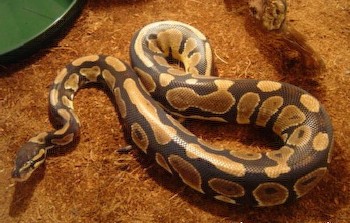 The color pattern is
typically black or dark brown with light brown or gold sides
and dorsal blotches. The belly is a white or cream that may
include scattered black markings. However, those in the pet
industries have, through selective breeding, developed many
morphs(genetic mutations) with altered colors and patterns. The color pattern is
typically black or dark brown with light brown or gold sides
and dorsal blotches. The belly is a white or cream that may
include scattered black markings. However, those in the pet
industries have, through selective breeding, developed many
morphs(genetic mutations) with altered colors and patterns.
Found
in Africa from Senegal, Mali, Guinea-Bissau, Guinea, Sierra
Leone, Liberia, Ivory Coast, Ghana, Benin, Niger and Nigeria
through Cameroon, Chad and the Central African Republic to
Sudan and Uganda. No type locality was given in the original
description. Prefers grasslands, savannas and sparsely
wooded areas.
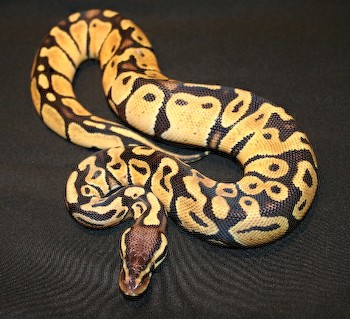 This
terrestrial species is known for its defense strategy that
involves coiling into a tight ball when threatened, with its
head and neck tucked away in the middle. In this state, it
can literally be rolled around. The python also has the
tendency to hiss loudly when it feels threatened. Favored
retreats include mammal burrows and other underground hiding
places where they also aestivate. In captivity they are
considered good pets, for their relatively small size and
placid nature make them easy to handle. Captive bred adults
rarely bite. This species is particularly revered in the
traditional religion of the Igbo people of southeastern
Nigeria. It is considered symbolic of the earth, being an
animal that travels so close to the ground. Even among many
Christian Igbos, these pythons are treated with great care
whenever they happen to wander into a village or onto
someone's property; they are allowed to roam freely or are
very gently picked up and placed out in a forest or field
away from any homes. If one is accidentally killed, many
communities in Igboland will still build a coffin for the
snake's remains and give it a short funeral. This
terrestrial species is known for its defense strategy that
involves coiling into a tight ball when threatened, with its
head and neck tucked away in the middle. In this state, it
can literally be rolled around. The python also has the
tendency to hiss loudly when it feels threatened. Favored
retreats include mammal burrows and other underground hiding
places where they also aestivate. In captivity they are
considered good pets, for their relatively small size and
placid nature make them easy to handle. Captive bred adults
rarely bite. This species is particularly revered in the
traditional religion of the Igbo people of southeastern
Nigeria. It is considered symbolic of the earth, being an
animal that travels so close to the ground. Even among many
Christian Igbos, these pythons are treated with great care
whenever they happen to wander into a village or onto
someone's property; they are allowed to roam freely or are
very gently picked up and placed out in a forest or field
away from any homes. If one is accidentally killed, many
communities in Igboland will still build a coffin for the
snake's remains and give it a short funeral.
|
Top of Page
|
Saharan Sand Boa
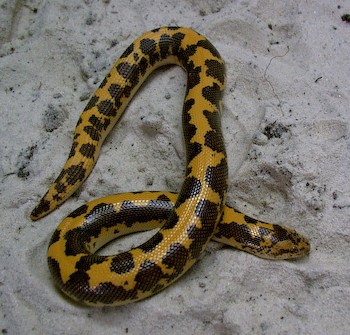 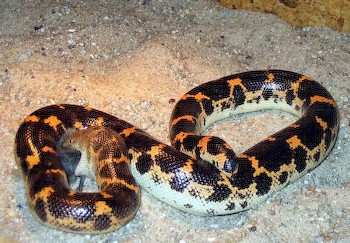 Gongylophis
is a genus of non-venomous boas found in mostly in Africa
and the Indian subcontinent. Currently, 3 species are
recognized. Gongylophis
is a genus of non-venomous boas found in mostly in Africa
and the Indian subcontinent. Currently, 3 species are
recognized.
Found
in Africa from Mauritania and Senegal east to Egypt and
south to Tanzania. Also reported from the southern tip of
the Arabian Peninsula. In the Indian subcontinent the genus
is found from eastern Pakistan, eastern India and Bangladesh
southwards as far as north-western Sri Lanka. In Africa
along the southern edge of the Sahara, from Mauritania,
Senegal and Sierra Leone, eastwards through Burkina Faso,
Ghana, Togo, Benin, Nigeria and Chad to eastern Sudan.
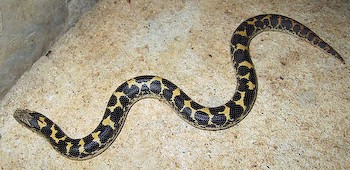
|
Top of Page
|